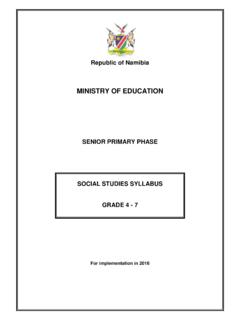Transcription of MAIZE PRODUCTION MANUAL - IITA
1 MAIZE . PRODUCTION . MANUAL . VOLUME I CHAPTERS 1- 9. MANUAL Series No. 8. MAIZE . PRODUCTION . MANUAL . VOLUME I CHAPTERS 1-9. APRIL 1982. Published and printed at Intemationallnstitute of Tropical Agriculture Oyo Road, PMB 5320. ~badan , Nigeria MANUAL Series No. 8. - i - TABLE OF CONTENTS. Foreward if Chapter 1. History and Origin of MAIZE 1. Chapter 2. Importance of MAIZE in Africa, 4. Chapter 3. Botany of MAIZE 13. Chapter 4. Physiology of MAIZE ?O. Chapter 5 MAIZE Cudtivation 36. (i) Climatic Requirements 36. (11) Soils 44. Chapter 6. Soil Preparation and Planting 82. (i) Seed Preparation 82. (ii) Planting and Population Density 91.
2 Chapter 7. Fertilizers and Manurafl 106. Chapter 8. (i) Weed Biology 2nd Control in MAIZE 147. (ii) MAIZE Mechanization for the Small Farmer 158. Chapter 9. MAIZE Breeding ~1ethods 192. Chapter 10. Seed PRODUCTION , T~9ting and Handling 219. Chapter 11. Plant Diseases 254. Chapter 12. Insect Pests 312. Chapter 13. Nematodes as Pests of Economic Plants 334. Chapter 14. Integrated Pest Management in MAIZE PRODUCTION 373. Chapter 15. Harvesting and Storage. 378. - ii- FOZ'eward This MANUAL has been compiled to pr01lide information and guidelines relating to all aspects of MAIZE PRODUCTION in the hunid and sub-~umid tropics of Africa.
3 It is designed to senre as a basic reference document for participants in IITA's MAIZE training courses. Our sincere thanks go to the follo~l7ing scientists yTho contributed chapters to the MANUAL (by alphabetical order): Dr. I. O. Al~obundu, Scientist~ I ITA. Dr. Asoon1, MAIZE Breeder, lITA/SAFfJRAD, Upper Volta. Dr. P. Ay, Socio-economist, IITA. Dr. W. B. Boshoff, Head, Dept. of Agric. Engineering t Bunda College, Mala1Yi. Dr. Caveness, Nematologist, lITA. Dr. J .M. Fajemisin, MAIZE Pathologist-Breeder, National Cereals Research Institute, Nigeria. ~1r. Garman!> Agricultural Engineer, IITA. Dr. A. Joshua, Director, National Seed Service, Nigeria.
4 Dr. Kim, MAIZE Breeder, lITA. Dr. R. Lal, Soil Physicist, IITA. Dr. R. Uarkham, Storage Entomologist, Tropical Prooucts Institute. Dr. S. Pandey~ Extension SpeCialist, IITA/PRONAM, Zaire. Dr. Uriyo9 Training Officer (Agronomist) ~ IITA. We also thank -the following scientists who reviaved the materials that are included in the MANUAL (by al~habetical order). Dr. Alam, Entomologist, IITA. Dr. ~{. S. Bjarnason, MAIZE Breeder, CI oMYT Liaison at IIT<~. Dr. Y. Efron, MAIZE Breeder, IITA. Dr. Khadr, MAIZE Breeder, IITA/FEC. Dr. Kim, Haize Breeder, IITA. - iii - Special mention should be made of the efforts of Dr /I. P. TJriyo, Training Officer (Agronomist) at IITA.}
5 ,ho compiled this oanualj of Hr Korama , Assistant Agronomist, Integrated f~ricultural Development Project , ministry of Agriculture and Forestry, Northern Area-Makeni. Sierra Leone. who coordinated the editing and proofreading of the text, and to the secretarial and graphic art staff of the Institute for their contri~ution. Mention in the text of trade names of certain products does not con- stitute approval by rITA to the exclusion of other products that may also be suitable. It is our hope that this MANUAL will be of assistance to the many research workers and extension supervisors who come to IITA for further training in MAIZE PRODUCTION in tropical Africa.
6 Hade H. Reeves Assistant Director Head of Training. CHAPTER 1. HISTORY AND ORIGIN OF MAIZE . - MAIZE is thought to have originated at least 5000 years ago in the highlands of Mexico, Peru, Ecuador, and/or Bolivia because of the great density of native forms found in the region. There have been four principal and several minor theories regarding the origin of MAIZE : (1) the cultivated MAIZE originated from pod corn, a form in which the individual kernels are enclosed in floral brackets as they are in other cereals and in the majority of. grasses; (2) that MAIZE originated from its closest relative, teosinte, by direct selection, by mutatinns, or by hybridization of teosinte vnth an unknown grass now extinct; (3) that MAIZE teosinte, Tripsaaum have descended along independent lines directly from a common ancestor; (4) the tripartite theory of Mangelsdorf and Reeves (l939~ 1945) that (a) cultivated MAIZE originated fran pod corn (b) teosinte a derivative of a hybrid of MAIZE and Tripsacum, (c) the majority of modern MAIZE varieties are the produc t of admixture with teosinte or Pripsaaum or both.
7 Other hypotheses called "minor" in the sense that they have had little ". effect upon the thinking and experimentation concerned idth the origin of MAIZE are: (1) that cultivated MAIZE originated from papyrescent corn, a type superficially resembling a weak form of pod corn; (2) that MAIZE is an allopolyp1oid hybrid originating in South-East Asia by the hybridization of two ten-chromosome species such as Coix and So~hum. Despite these theories the origin of MAIZE remains speculative and controversial as none of the theories is entirely satisfactory. Introduction of MAIZE in Africa: There is evidence that MAIZE from Central and South is in- troduced to Europe in 1492 by Columbus~ and then spread to Africa (Van - 2 - Later in the 15th Century, the Caribbean Flint became the most predominant type of MAIZE in Africa.)
8 It was introduced into East Africa by explorers from Portugal and the Persian Gulf, (Obilana and Asnani). MAIZE became an important crop in Africa only after 1900 when different types 'l7ere introduced by the Dutch in South Africa (Saunders, 1930). The most successful types, which eventually moved into East Africa, were Hickory King, Hhite Horsetroth, Ladysmith White. Salisbury White, Champion \-1hite, Pearl and Iowa Silver Mine (Harrison, 1976). Kenya Flat ~fuite was introduced by European settlers. Some admixture ~Yith the local Caribbean Flint must have taken place, which probably accounts for the proportion of yellow and purple kernels seen in small farmers~ fields.
9 The local yellow MAIZE in East Africa probably was derived from the early introductions of the Caribbean Flint and from later introductions of yellow dents from South Africa. The last distinct type of MAIZE to arrive in East Africa was the high altitude race Cuzco from Peru (Grobman et al., 1961). It was brought by missionaries before the 1914-1918 war. Its soft flour kernel is the largest of any type of MAIZE , and it is the only type of MAIZE now grm-m at altitudes above 2500 metres. Since its introduction into Africa, MAIZE has been cultivated extensively in East and West Africa, and has spread to Senegal, Upper Volta and Niger Republic.
10 In Hest Africa, bvO main types of MAIZE can be identified, the Northern Flints and Southern Flours or Coastal Flours. The Northern Flint probably is related to the Caribbean Flint \vhile the floury types probably are related to those of central and south America. Because of its long-term cultivation in different parts of Africa, the crop has developed adaptations to many niches. Such diversity has formed land races called local varieties. - 3 - REFERENCES. 1. Grobman, A., W. Sa1huana, R. Sevilla and 1o' (1961). Races of MAIZE in Peru; their origins, evolution and classification. Nat. Acad. Sci. Washington Publ. 2. Harrison, E.




